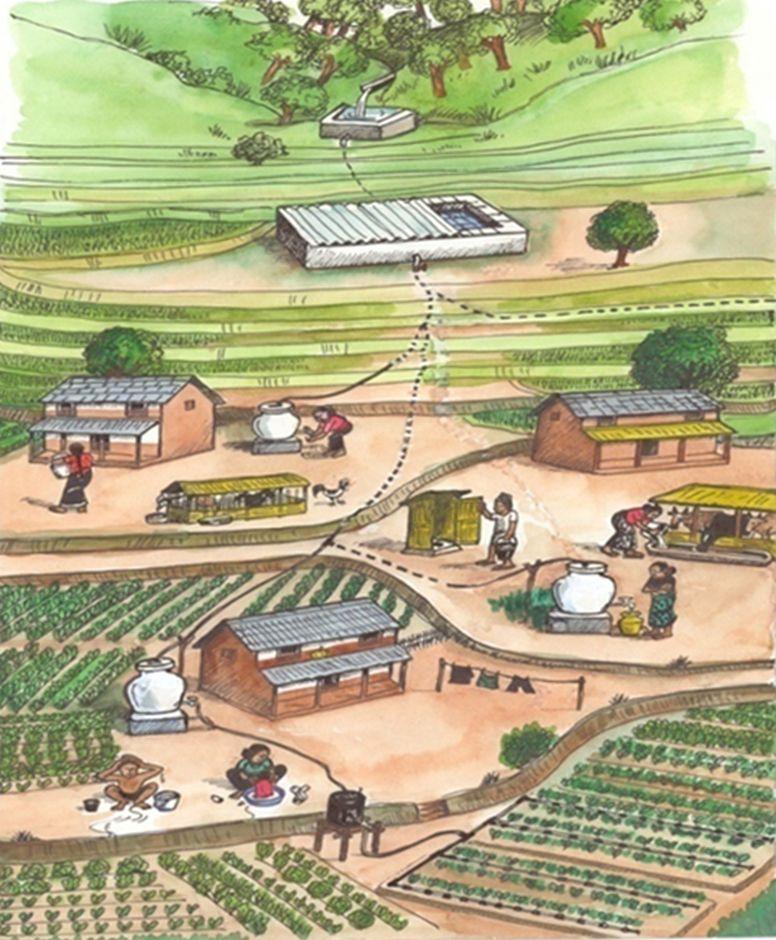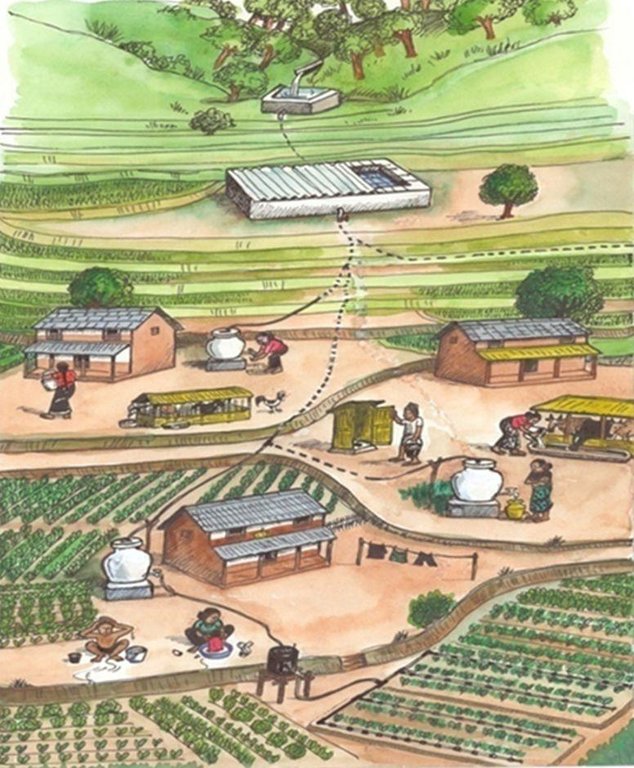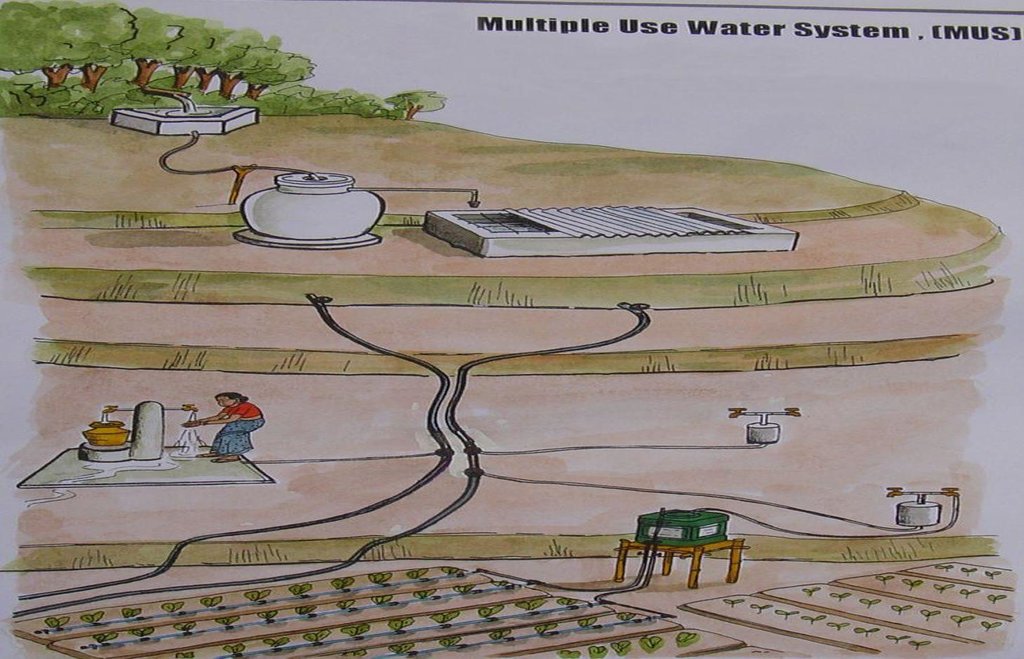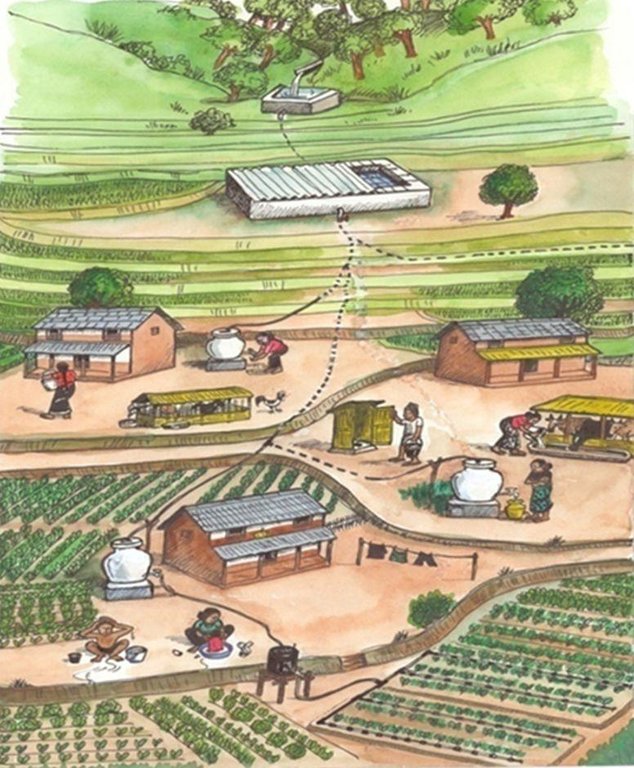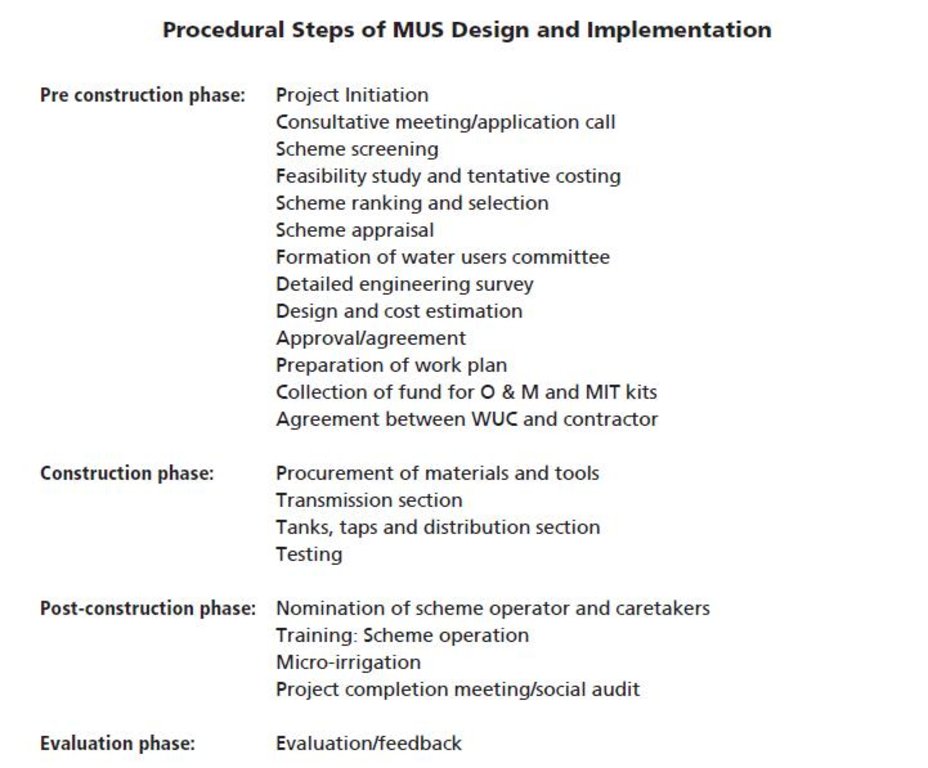A multiple-use water system [เนปาล]
- ผู้สร้างสรรค์:
- การอัพเดท:
- ผู้รวบรวม: Shreedip Sigdel
- ผู้เรียบเรียง: –
- ผู้ตรวจสอบ: Fabian Ottiger
Bahu uddhasaya Pani prayog pranali (Main contributor: Parmananda Jha, IDE/Nepal)
approaches_2532 - เนปาล
ดูส่วนย่อย
ขยายทั้งหมด ย่อทั้งหมด1. ข้อมูลทั่วไป
1.2 รายละเอียดที่ติดต่อได้ของผู้รวบรวมและองค์กรที่เกี่ยวข้องในการประเมินและการจัดเตรียมทำเอกสารของแนวทาง
ผู้เชี่ยวชาญ SLM:
Jha Parmananda
98487 28274 / 97495 12791 (M)
pjha@idenepal@org / jhap-2003@yahoo.com
Food Security Project, Regional Office, Banke Bagiya, Shantinagar,Nepalgunj
เนปาล
ชื่อของโครงการซึ่งอำนวยความสะดวกในการทำเอกสารหรือการประเมินแนวทาง (ถ้าเกี่ยวข้อง)
iDE Nepal (iDE Nepal) - เนปาลชื่อของโครงการซึ่งอำนวยความสะดวกในการทำเอกสารหรือการประเมินแนวทาง (ถ้าเกี่ยวข้อง)
ICIMOD International Centre for Integrated Mountain Development (ICIMOD) - เนปาล1.3 เงื่อนไขที่เกี่ยวข้องกับการใช้ข้อมูลที่ได้บันทึกไว้ผ่านทาง WOCAT
วันที่เก็บรวบรวมข้อมูล (ภาคสนาม):
01/03/2013
ผู้รวบรวมและวิทยากรหลักยอมรับเงื่อนไขเกี่ยวกับการใช้ข้อมูลที่ถูกบันทึกผ่านทาง WOCAT:
ใช่
2. คำอธิบายของแนวทาง SLM
2.1 การอธิบายแบบสั้น ๆ ของแนวทาง
A multiple-use water system gives a community access to water for domestic use and water for crop irrigation.
2.2 การอธิบายอย่างละเอียดของแนวทาง
การอธิบายอย่างละเอียดของแนวทาง:
Aims / objectives: A multiple-use water system (MUS) is a combined water facility that has proven useful as a means of providing drinking water and water for irrigation for smallholder farmers in the hilly areas of Nepal. Water is collected by gravity from a highland source into a holding tank and is shared by means of distribution lines, domestic tap stands, and irrigation off-take lines. It can also support application of micro-irrigation technologies (MIT) such as drip and micro sprinkler irrigation systems.
Methods: MUS is a community-managed system that caters mainly to smallholder landowners and marginal households in rural hilly areas. When properly implemented, it can help to alleviate poverty and increase food security for poor and marginalized groups. The first priority is to provide drinking water and water for domestic use to the community; any excess water is used for agriculture and irrigation.
Stages of implementation: The following points should be taken into consideration before a community establishes a MUS:
• The source of water should be clear of water-rights issues
• The water should be plentiful and of good quality
• There needs to be a sufficient drop in gradient between the source and the tank if the water is to be collected by gravity. If the drop is not sufficient, users should be prepared to consider lifting the water.
• The distance between the source and the village should be less than 3 km.
• The community should be ready to contribute unskilled labour as part of their contribution to the project.
• The community should be ready to put aside some funds for operational and maintenance costs; these funds can, in part, also be collected in the form of monthly users' fees.
• At least 70% of the water users should be ready to adopt micro-irrigation technologies (MIT) such as drip and sprinkler irrigation.
2.3 รูปภาพของแนวทาง
2.5 ประเทศ ภูมิภาค หรือสถานที่ตั้งที่ได้นำแนวทางไปใช้
ประเทศ:
เนปาล
ข้อมูลเฉพาะเพิ่มเติมของสถานที่ตั้ง:
Kaski, Lamjunj, Tanahun, Dhading, Sangjya, Gulmi, Arghakhanchi, Palpa, Udayapur, Pyuthan, Rolpa, Ruk
2.7 ประเภทของแนวทาง
- ใช้โครงงานหรือแผนงานเป็นฐาน
2.8 เป้าหมายหรือวัตถุประสงค์หลักของแนวทาง
The Approach focused mainly on other activities than SLM (Collect water from a small-scale source and distribute it both for domestic use and for the production of vegetables and high value crops)
• To provide a regular supply of water for domestic and agricultural use
• To supply water for micro-irrigation technologies such as drip and sprinkler irrigation systems
• To improve health and sanitation
• To help smallholder landowners improve their incomes and livelihoods as well as to adapt to climate change by having access to a regular supply of water so that they can grow crops regardless of changes
• To conserve water by using it more wisely
The SLM Approach addressed the following problems: The community needs to prioritize how it will partition the water for domestic use and for irrigation.
2.9 เงื่อนไขที่เอื้ออำนวยหรือเป็นอุปสรรคต่อการนำเทคโนโลยีภายใต้แนวทางนี้ไปปฏิบัติใช้
บรรทัดฐานและค่านิยมทางสังคม วัฒนธรรม ศาสนา
- เป็นอุปสรรค
Management and operation of system
Treatment through the SLM Approach: Strong social mobilization is needed
กรอบแนวทางในการดำเนินการด้านกฎหมาย (การถือครองที่ดิน สิทธิในการใช้ที่ดินและน้ำ)
- เอื้ออำนวย
The existing land ownership, land use rights / water rights helped a little the approach implementation: Since this approach uses small spring sources of water, there is usually only a minimum risk of conflict for water use. When the water source is registered with the local authorities, it helps to reduce potential conflicts over water rights between communities.
ความรู้เกี่ยวกับ SLM การเข้าถึงการสนับสนุนด้านเทคนิค
- เป็นอุปสรรค
Water supply insufficient to meet the demand
Treatment through the SLM Approach: Increase the capacity of the storage tank
อื่นๆ
- เป็นอุปสรรค
The community often cannot agree whether to scale up the domestic or the irrigation water supply.
Treatment through the SLM Approach: Concerned stakeholders need to confer and agree
3. การมีส่วนร่วมและบทบาทของผู้มีส่วนได้ส่วนเสียที่เกี่ยวข้อง
3.1 ผู้มีส่วนได้ส่วนเสียที่เกี่ยวข้องในแนวทางนี้และบทบาท
- ผู้ใช้ที่ดินระดับท้องถิ่นหรือชุมชนระดับท้องถิ่น
This included women, men, dalits, janjati, brahmin, chhetri
- ผู้เชี่ยวชาญ SLM หรือที่ปรึกษาการเกษตร
- ครู เด็กนักเรียน หรือนักศึกษา
- องค์กรพัฒนาเอกชน
IDE Nepal
- รัฐบาลแห่งชาติ (ผู้วางแผน ผู้ทำการตัดสินใจ)
3.2 การเกี่ยวข้องของผู้ใช้ที่ดินระดับท้องถิ่นหรือชุมชนระดับท้องถิ่นในช่วงต่างๆของแนวทาง
| ความเกี่ยวข้องของผู้ใช้ที่ดินระดับท้องถิ่นหรือชุมชนระดับท้องถิ่น | ระบุผู้ที่มีส่วนเกี่ยวข้องและอธิบายกิจกรรม | |
|---|---|---|
| การริเริ่มหรือการจูงใจ | ปฏิสัมพันธ์ | The community comes to a consensus on their water needs. They identify a source that it is within the 3 km limit and investigate the water use rights. |
| การวางแผน | ระดมกำลังด้วยตนเอง | Technical aspects are dealt with; these include assessing the source to verify whether it has an adequate supply of water, assessing different schemes (for intake, take off, tap stands, and the like), preparing a design and estimating the cost, and discussing funding. |
| การดำเนินการ | ระดมกำลังด้วยตนเอง | A users' committee is formed and the community provides unskilled labour. Technical assistance is provided by INGOs/NGOs. |
| การติดตามตรวจสอบหรือการประเมินผล | ระดมกำลังด้วยตนเอง | The work is monitored by the users' committee but monitoring and evaluation of technical aspects are provided by INGOs/NGOs at different times during the project. |
| Research | ไม่มี |
3.3 แผนผังแสดงขั้นตอนการทำงาน (ถ้ามี)
3.4 การตัดสินใจเลือกใช้เทคโนโลยี SLM
ระบุผู้ที่ทำการตัดสินใจเลือกเทคโนโลยีมากกว่าหนึ่งวิธีไปปฏิบัติใช้:
- ผู้ใช้ที่ดินเพียงผู้เดียว ( ริเริ่มด้วยตัวเอง)
การอธิบาย:
The community discusses and makes a decision on the type of water supply system they would like and specifies how they would like to apportion water for domestic and agricultural use. They submit a proposal to the concerned authorities.
Decisions on the method of implementing the SLM Technology were made by mainly by land users supported by SLM specialists. Technical support is provided by IDE Nepal in collaboration with different national and international non-governmental organizations, government organizations, and local bodies.
4. การสนับสนุนด้านเทคนิค การสร้างขีดความสามารถ และการจัดการด้านความรู้
4.1 การสร้างขีดความสามารถ / การอบรม
ได้มีการจัดอบรมให้แก่ผู้ใช้ที่ดินหรือผู้มีส่วนได้ส่วนเสียคนอื่น ๆ หรือไม่:
ใช่
ให้ระบุว่าใครเป็นผู้ได้รับการอบรม:
- เจ้าหน้าที่ภาคสนาม / ที่ปรึกษา
- Community
รูปแบบการอบรม:
- เกษตรกรกับเกษตรกร
หัวข้อที่พูด:
The approach provided training to the community through the users' committee, field staff, and an agricultural advisor. The local skilled body is trained during site visits. For the most part, information is transferred from farmer to farmer. Much of the training is hands-on.
4.2 การบริการให้คำแนะนำ
ผู้ใช้ที่ดินมีการเข้าถึงการรับบริการให้คำปรึกษาหรือไม่:
ใช่
ระบุว่ามีบริการให้คำปรึกษาหรือไม่:
- ที่ศูนย์ถาวร
การอธิบาย/แสดงความคิดเห็น:
An advisory service is provided for the land/water users, but what is given is usually insufficient to help farmers learn new techniques such as micro-irrigation.
4.3 การเสริมความแข็งแกร่งให้กับสถาบัน (การพัฒนาองค์กร)
สถาบันได้รับการจัดตั้งขึ้นมาหรือเสริมความแข็งแกร่งโดยแนวทางนี้หรือไม่:
- ใช่ ปานกลาง
ระบุระดับของสถาบันที่ได้รับการเสริมความแข็งแกร่งหรือจัดตั้งขึ้นมา:
- ท้องถิ่น
ระบุประเภทของการให้ความช่วยเหลือสนับสนุน:
- การสร้างขีดความสามารถ / การอบรม
ให้รายละเอียดเพิ่มเติม :
village development committees, local governance and community development programmes (LCGDP), community forest user groups, youth clubs, and women's groups. Village development committees can invest in MUS and micro-irrigation technologies as specified in their guidelines.
4.4 การติดตามตรวจสอบและประเมินผล
การติดตามตรวจสอบและประเมินผลเป็นส่วนหนึ่งของแนวทางหรือไม่:
ใช่
ความคิดเห็น:
bio-physical aspects were regular monitored by project staff, land users through measurements; indicators: Project staff and land users routinely monitor the water source and other biophysical aspects to ensure that the approach remains sustainable.
technical aspects were regular monitored by land users through observations; indicators: Commercial vegetable or high value crop production, micro irrigation, drinking water and sanitation
socio-cultural aspects were ad hoc monitored through observations; indicators: MUS schemes help to improve sanitation and thereby reduce the incidence of waterborne diseases. They also help to improve livelihoods by making more fresh vegetables available both for immediate consumption and for sale.
economic / production aspects were monitored through observations; indicators: MUS schemes help to reduce drudgery; the labour saved can be used in the production of vegetables and other high value crops.
no. of land users involved aspects were monitored through measurements; indicators: From 10 to 80; on average 28 land users are involved in one MUS scheme
management of Approach aspects were monitored through observations; indicators: Participatory approach with collaboration by government organizations, INGOs/NGOs and others to provide routine inspections and technical support
There were no changes in the Approach as a result of monitoring and evaluation: The approach, as it is now put into practice, is a result of incorporating technological improvements that were originally identified through years of monitoring and evaluation.
There were no changes in the Technology as a result of monitoring and evaluation
4.5 การวิจัย
การวิจัยเป็นส่วนหนึ่งของแนวทางหรือไม่:
ใช่
ระบุหัวข้อเรื่อง:
- เทคโนโลยี
ให้ข้อมูลเพิ่มเติมและให้ระบุผู้ทำการวิจัย:
IDE has researched and implemented this type of MUS concept, system design, and methodology in Nepal since 2003; now other agencies also provide similar systems.
Research was carried out both on station and on-farm
5. การสนับสนุนด้านการเงินและวัสดุอุปกรณ์
5.1 ระบุงบประมาณประจำปีสำหรับแนวทาง SLM นี้
ถ้าหากว่างบประมาณประจำปีไม่เป็นที่ทราบแน่นอน ให้ระบุช่วงลงไป:
- 10,000-100,000
แสดงความคิดเห็น (แหล่งของการระดมทุน ผู้บริจาคคนสำคัญ):
Approach costs were met by the following donors: international non-government: 30.0%; local government (district, county, municipality, village etc): 26.0%; local community / land user(s): 44.0%
5.2 การสนับสนุนด้านการเงิน / วัสดุอุปกรณ์ให้แก่ผู้ใช้ที่ดิน
ผู้ใช้ที่ดินได้รับการสนับสนุนด้านการเงิน / วัสดุอุปกรณ์ไปปฏิบัติใช้เทคโนโลยีหรือไม่:
ใช่
ถ้าใช่ ให้ระบุประเภทของการสนับสนุน เงื่อนไขและผู้จัดหามาให้:
All MUS systems in Nepal are built by communities or community groups in collaboration with the government and NGOs. The fact that MUS systems provide multiple benefits is seen as a plus point for institutions looking to invest in community projects.
5.3 เงินสนับสนุนสำหรับปัจจัยนำเข้า (รวมถึงแรงงาน)
ถ้าแรงงานโดยผู้ใช้ที่ดินเป็นปัจจัยนำเข้าที่มีอยู่มากมาย ระบุด้วยว่าเนื่องจาก:
- จ่ายเป็นเงินสด
ความคิดเห็น:
Unskilled labour is provided by the community; skilled labour is provided by the implementing organization. The implementing organization pays for both the skilled and unskilled labour.
Materials that are available locally are contributed by the community. Materials that are not available locally are paid for out of project funds. Equipment, tools, and specialist materials are purchased through collaborative partners. Training programmes aimed at capacity building and upgrading skills are subsidized.
5.4 เครดิต
มีการจัดหาเครดิตมาให้ภายใต้แนวทาง SLM หรือไม่:
ไม่ใช่
6. การวิเคราะห์ผลกระทบและการสรุป
6.1 ผลกระทบของแนวทาง
ช่วยให้ผู้ใช้ที่ดินนำเอาเทคโนโลยี SLMไปใช้และบำรุงรักษาสภาพไว้ได้หรือไม่:
- ไม่ใช่
- ใช่ เล็กน้อย
- ใช่ ปานกลาง
- ใช่ อย่างมาก
The approach supports sustainable land management because micro- irrigation technologies promote optimal use of water and help to retain nutrients in the soil. Similarly, the production of high value crops and vegetables further increases the fertility of the soil.
ทำให้กลุ่มด้อยโอกาสมีอำนาจทางสังคมและเศรษฐกิจหรือไม่:
- ไม่ใช่
- ใช่ เล็กน้อย
- ใช่ ปานกลาง
- ใช่ อย่างมาก
The wellbeing of marginalized and socio-economically disadvantaged groups improves significantly.
Did other land users / projects adopt the Approach?
- ไม่ใช่
- ใช่ เล็กน้อย
- ใช่ ปานกลาง
- ใช่ อย่างมาก
Since the reduction in drudgery and the improvements in livelihoods are so great, many communities would like to implement this approach. INGOs/NGOs can help with the financial and technical aspects of implementation.
Did the Approach lead to improved livelihoods / human well-being?
- ไม่ใช่
- ใช่ เล็กน้อย
- ใช่ ปานกลาง
- ใช่ อย่างมาก
This approach helps to reduce drudgery and to improve sanitation; overall, it improves livelihoods and contributes to human wellbeing. It also increases the production of crops, and helps to conserve the soil and improve its fertility.
Did the Approach help to alleviate poverty?
- ไม่ใช่
- ใช่ เล็กน้อย
- ใช่ ปานกลาง
- ใช่ อย่างมาก
Through increased income from the production of vegetables and high value crops
6.2 แรงจูงใจหลักของผู้ใช้ที่ดินเพื่อที่จะนำ SLM ไปปฏิบัติใช้
- การผลิตที่เพิ่มขึ้น
- กำไร (ความสามารถ) อัตราส่วนค่าใช้จ่ายต่อผลประโยชน์ที่เพิ่มขึ้น
- well-being and livelihoods improvement
6.3 ความยั่งยืนของกิจกรรมของแนวทาง
ผู้ใช้ที่ดินสามารถทำให้สิ่งต่างๆ ที่ได้ปฏิบัติใช้โดยแนวทางนี้ยั่งยืนได้หรือไม่ (โดยไม่มีการสนับสนุนจากภายนอก):
- ใช่
ถ้าตอบว่าใช่ ให้อธิบายว่าอย่างไร :
Since the approach was requested by the community as a whole, they all have a vested interest in seeing that it remains sustainable. When technical support is needed, it can be obtained from the concerned agencies.
6.4 จุดแข็งและข้อได้เปรียบของแนวทาง
| จุดแข็ง / ข้อได้เปรียบของแนวทางในทัศนคติของผู้รวบรวมหรือวิทยากรหลัก |
|---|
| A reliable water supply for both the domestic and irrigation needs of hill farmers (How to sustain/ enhance this strength: The continued involvement of the community, the government, and assisting INGOs/NGOs.) |
| The MUS is a simple gravity system that does not require either sophisticated equipment or training. (How to sustain/ enhance this strength: Continue to investigate how it can be simplified even further) |
| A MUS system has a minimum lifespan of ten years and is easy to install even in remote areas. (How to sustain/ enhance this strength: Continue to investigate how it can be improved even further) |
| MUS is well suited to the dual purpose use of water for both domestic and agricultural use. (How to sustain/ enhance this strength: Continue research and development to see how it can be improved even further.) |
6.5 จุดอ่อน / ข้อเสียเปรียบของแนวทางและวิธีในการแก้ไข
| จุดอ่อน / ข้อเสียเปรียบในทัศนคติของผู้รวบรวมหรือวิทยากรหลัก | สามารถแก้ไขปัญหาได้อย่างไร |
|---|---|
| Installation costs can be a challenge for very poor communities. It can only irrigate small areas (0.1-0.15ha). | Installation costs can usually be recovered within 1 year when the irrigation water is used to produce high value crops. |
| The intake and reservoirs need to be inspected regularly. | Either devise a means to ensure that inspections are conducted regularly or find a system that requires fewer inspections |
| Reservoir tanks and intake pipes can deteriorate over time and pipes and joints can start to leak. | Local skilled labour can be employed to carry out needed repairs. Pipes and fittings should be checked regularly. Routine inspection and maintenance are essential. |
| Costs can be high when imported materials are needed for repair and maintenance. | At the outset, some money needs to be set aside for operation and maintenance costs; additional funds should be collected by charging monthly users' fees. |
7. การอ้างอิงและการเชื่อมต่อ
7.1 วิธีการหรือแหล่งข้อมูล
- ไปเยี่ยมชมภาคสนาม การสำรวจพื้นที่ภาคสนาม
- การสัมภาษณ์กับผู้ใช้ที่ดิน
7.2 การอ้างอิงถึงสิ่งตีพิมพ์
ชื่อเรื่อง ผู้เขียน ปี ISBN:
Multiple use water service implementation in Nepal and India: Experience and lessons for scale-up, Mikhail, M; Yoder, R (2008)
ช่องทางในการสืบค้น และราคา:
http://www.ideorg.org/OurStory/IDE_multi_use_water_svcs_in_nepal_india_8mb.pdf
ลิงก์และโมดูล
ขยายทั้งหมด ย่อทั้งหมดลิงก์
ไม่มีลิงก์
โมดูล
ไม่มีโมดูล


